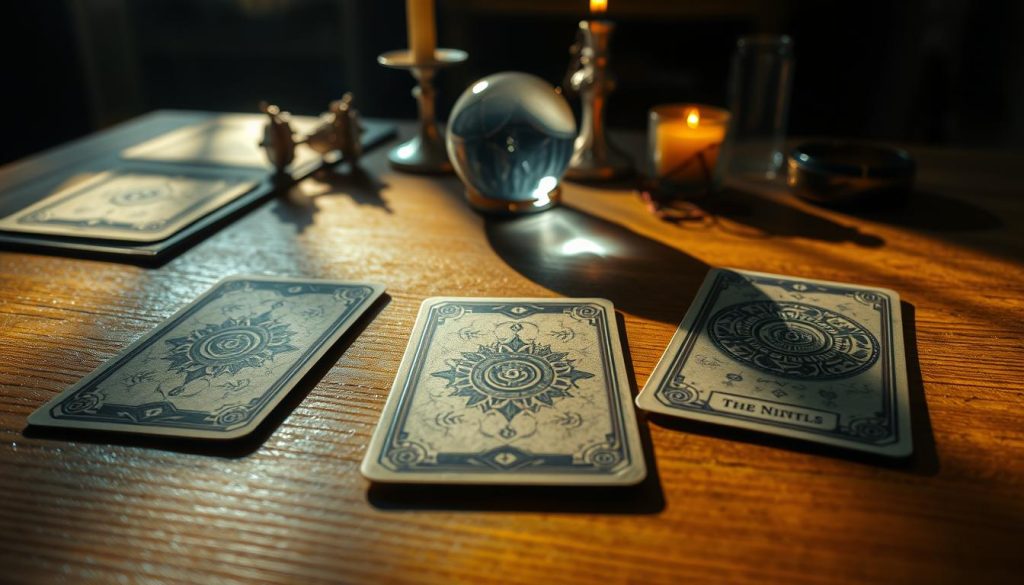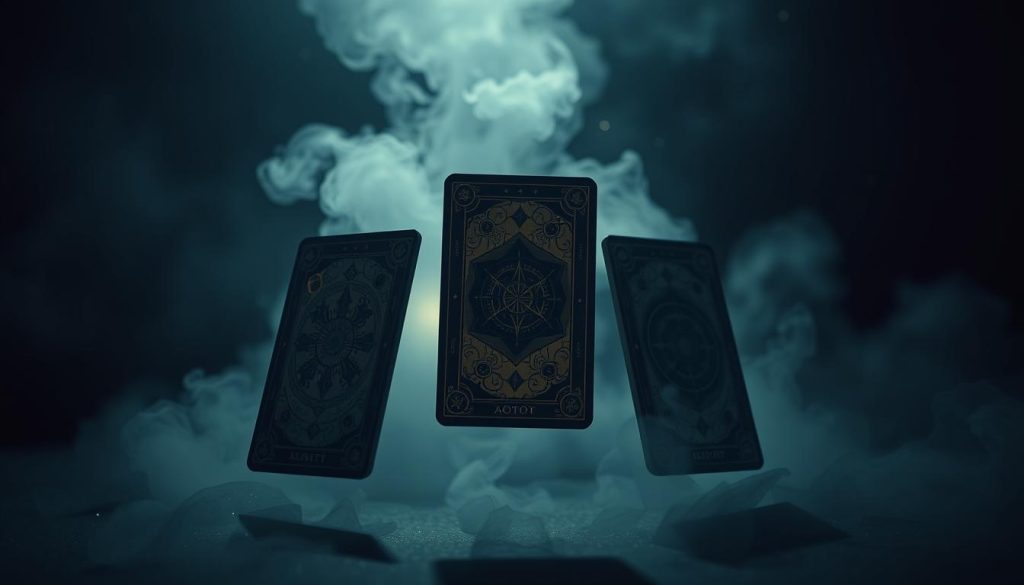We set the scene for a calm, focused check-in that fits into a busy day. These small layouts give a clear signal fast, so you can decide the next step without fuss.
Three cards and a simple line or triangle let images talk to each other. The visual layout shows relationships, so clustered or mirrored placements can point to cause, effect, or relationship themes.
Use this guide as a friendly map to popular tarot mini layouts. They act as building blocks that scale into larger spreads when a question needs more time and depth.
We invite you to get started with approachable techniques that honor intuition while offering structure. Short sessions can still deepen understanding and become steady anchors on busy days.
Why Three Cards Deliver Fast, Focused Tarot Reading Insights
Three simple cards can map a clear story fast, giving us a gentle, focused snapshot when time is short. We like small layouts because they balance simplicity with real depth. A tight arrangement gives context, energy, and a direction without overloading the mind.
Visual layout guides interpretation. Left-to-right lines feel like sequence. Triangles feel like balance. Overlaps read as blocks or crossings. The space between cards becomes part of the message.
Different layout types — linear path, triangular balance, causal advice, and cross/challenge — shape how each card speaks to the others. Reading multiple cards together builds a narrative and deepens our understanding.
Symmetry helps with relationship work. Each card can mirror a person, a perspective, or a role. That makes mapping dynamics kinder and clearer.
Practice noticing repeats. Suits, numbers, or themes that recur across cards often point to the reading’s main thread. Let the tarot card images — posture, color, gaze — anchor the story and guide what to explore next.

How to Do a Three-Card Tarot Spread Right Now
A gentle pause, a focused question, and three cards can turn a blur into a bright idea. Begin by naming a clear intention. Breathe. Hold that phrase while you shuffle the deck.
Set intention, shuffle, cut, draw. Shuffle until you feel present. Cut the deck roughly in half. Draw three cards and place them with calm purpose.
Lay out positions clearly: decide if the line will be Past/Present/Future or Situation/Action/Outcome. Place cards left-to-right or as a triangle so each position holds meaning.
When you read tarot, look for patterns: repeating suits, numbers, or directional gazes. Ask how the middle card links the first and last. Use a deck booklet or online cheat sheet if you need help.
Keep it simple: use open questions, jot two quick notes, and make this a short routine. Routine beats perfection and helps you get started with an easy three-card tarot practice.

Linear Path Spreads: From Situation to Outcome
Tracing a path with three cards helps us watch cause and effect unfold step by step. Linear layouts point from A to B. They ask us to read left to right and follow motion.

Past, Present, Future
We use Past/Present/Future when timing matters. The first card gives context. The middle card shows current energy. The last card hints at likely events ahead.
You, Your Path, Your Potential
This variant maps standing, movement, and growth. Read it as a personal map. It helps turn insight into a practical way forward.
Situation, Action, Outcome
Pick this when you want steps. Identify the situation, ask for a focused action, and note the probable outcome. It’s useful for short, clear reading work.
Idea, Process, Aspiration
Use this to move an idea from spark to vision. Track directional imagery and suit progressions to see momentum or needed pivots. Finish by summarizing one sentence that ties the thread into a crisp compass for the next move.
Triangular Balance Spreads: Three Pillars, One Picture
When we place cards at the corners of a triangle, each position holds equal weight and meaning.
The triangle acts like a tripod. Remove one pillar and the structure shifts. We read each card as a pillar that supports the whole view.
Mind, Body, Spirit: check which pillar needs care so energy can realign.
Physical, Emotional, Spiritual States: map layered well‑being instead of chasing a single fix.
Subconscious, Conscious, Superconscious: bridge inner whispers with waking insight and higher guidance.
Option One, Option Two, Option Three: weigh pros, cons, and resonance. Try the “option option” contrast to tease out nuance.
What I Think, What I Feel, What I Do: notice small mismatches and adjust one habit to unlock flow.
We watch how each tarot card echoes or opposes the others. Matching suits can show harmony; mixed elements may ask for recalibration.
Finish with one alignment action that brings the three pillars closer together and turns balance into motion.
Causal Advice Spreads: Given X and Y, Here’s Z
When two forces meet, a third card often names the clear move forward.
We frame the layout as an equation: X + Y → Z. That keeps advice grounded in real inputs and makes the result actionable.
Strengths + Weaknesses → Advice
Place a strength and a blind spot side by side. The third card shows where to leverage power and where to tread gently.
What Worked + What Didn’t → Key Lesson
Read a success and a miss together. Let the Z-card name one lesson you can reuse or stop doing now.
Together + Apart → Focus
Map shared values next to personal space. The final card points to the focus that keeps relationships steady and kind.
My Wants + Partner’s Wants → Direction
Put both needs on the table. The third card often suggests a compromise or a clear next conversation to try.
Option A + Option B → Decision Insight
Compare two paths, then let the third card highlight which way feels alive. Capture that Z-card as a one-line micro-plan to act on today.
The trick: treat the third tarot card as a mantra or step. Write it down. Do one small move before the day ends.
Cross and Challenge Spreads: Navigating Obstacles
A crossing placement highlights what’s getting in the way and where to aim your energy.
We center the current situation with the first card, then place a crossing card to name the friction clearly. The third position steps back and offers advice or a synthesis. This pattern keeps the reading tight and kind.
Situation, Obstacle, Advice
Start with the situation. Lay the obstacle across it. Use the third card as practical counsel. This simple tarot spread helps turn snag into a next step.
Aspiration, Obstacle, How to Overcome
Place desire first, the block second, and a how-to third. We treat the middle card as the bridge. Then pick one action you can try today.
Opportunities, Challenges, Outcome
We map both sides: upside, friction, and likely events. Look for elemental clashes—fire versus water—to see why momentum stalls and where to adjust.
Thesis, Antithesis, Synthesis
Hold two opposing truths and let the third card fold them into a creative solution. Two-card versions work well when time is tight; keep the third for sharper guidance.
Keep the spread clean. Aim for one small, doable move the reading suggests. That turns insight into action and helps you meet challenges with steady curiosity.
3-Card Tarot Spreads for Quick Clarity in 2025: Your Next Step
Match your need with a short layout, draw three cards, and capture the clearest takeaway.
Set intention, shuffle, cut the deck, and assign positions. Keep the same surface and breath as a tiny ritual so your deck becomes a steady ally.
Write one sentence that names a small action you can do today. Use a journal entry with the date, positions, and a quick note on outcome.
Try different layouts—line, triangle, or causal—and use booklets or online tools to expand skill. For a playful stretch, draw a mini reading each day for seven days and watch how your readings sharpen and your potential unfolds.
